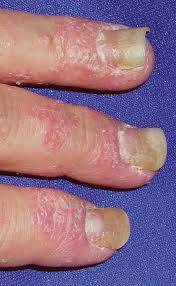Psoriatic Arthritis
Psoriatic arthritis (PsA) is a chronic inflammatory condition that affects some people who have psoriasis, a skin disease characterized by red, scaly patches. PsA causes joint pain, stiffness, and swelling, often affecting fingers, toes, and other joints. If untreated, it can cause joint damage and deformities.
---
20 Causes of Psoriatic Arthritis
1. Genetics: A family history of psoriasis or PsA increases the risk.
2. Autoimmune Response: The immune system attacks healthy joints and skin tissue.
3. Psoriasis: Having psoriasis, especially severe psoriasis, is the biggest risk factor.
4. Environmental Factors: Triggers such as infections can activate the immune response.
5. Skin Trauma: Injury or trauma to the skin may increase the likelihood of developing PsA.
6. Infections: Viral or bacterial infections may trigger inflammation leading to PsA.
7. Stress: Physical or emotional stress can trigger an autoimmune response.
8. Obesity: Excess body weight contributes to inflammation and stress on the joints.
9. Hormonal Changes: Hormonal shifts, especially in women, can trigger PsA.
10. Smoking: Smoking is linked to a higher risk of developing PsA.
11. Alcohol Consumption: Excessive alcohol intake may worsen inflammation.
12. Joint Trauma: Injuries to joints may increase the likelihood of PsA in susceptible individuals.
13. Immune System Abnormalities: Dysfunction in the immune system can lead to joint inflammation.
14. Gut Dysbiosis: An imbalance of gut bacteria can influence immune responses and inflammation.
15. Metabolic Syndrome: Conditions like hypertension and high cholesterol are linked to PsA.
16. Vitamin D Deficiency: Low levels of vitamin D have been associated with autoimmune diseases.
17. Allergies: Chronic inflammation from allergic reactions may contribute to PsA development.
18. Exposure to Toxins: Certain chemicals or pollutants may trigger autoimmune conditions.
19. Family History of Arthritis: Close relatives with arthritis may increase the risk.
20. Ethnicity: Certain ethnic groups, especially Caucasians, have a higher incidence of PsA.
---
20 Signs and Symptoms of Psoriatic Arthritis
1. Joint Pain: Persistent pain in affected joints, especially in the fingers, toes, knees, and lower back.
2. Swelling in Joints: Joints become swollen and tender, often affecting smaller joints like fingers and toes.
3. Stiffness: Joint stiffness, especially in the morning or after periods of inactivity.
4. Dactylitis: "Sausage-like" swelling of entire fingers or toes.
5. Back Pain: Pain and stiffness in the lower back or neck, indicating axial PsA.
6. Psoriasis Lesions: Red, scaly patches of skin, often on the scalp, elbows, or knees.
7. Fatigue: Extreme tiredness and lack of energy, common with chronic inflammation.
8. Nail Changes: Pitting, ridging, or separation of the nail from the nail bed (onycholysis).
9. Tenderness at Tendon Attachments: Pain where tendons and ligaments attach to bones (enthesitis).
10. Reduced Range of Motion: Difficulty moving joints fully due to stiffness and pain.
11. Eye Inflammation: Conditions like uveitis or conjunctivitis, causing redness and pain in the eyes.
12. Swollen Ankles or Feet: Fluid retention or inflammation in the lower extremities.
13. Pain in the Heel: Plantar fasciitis or Achilles tendon inflammation.
14. Skin Rashes: Psoriasis-related rashes that may worsen with arthritis flares.
15. Warmth in the Joints: Joints may feel warm to the touch due to inflammation.
16. Sacroiliac Joint Pain: Pain in the pelvis and lower back due to inflammation of the sacroiliac joint.
17. Depression or Anxiety: Mental health challenges due to chronic pain and discomfort.
18. Thickened Nails: Nails may thicken or become discolored.
19. Flare-ups: Periods of increased disease activity, with more intense symptoms.
20. Weight Loss: Unintentional weight loss due to chronic inflammation and disease activity.
---
10 Effects of Psoriatic Arthritis
1. Joint Deformity: Untreated PsA can lead to permanent joint damage and deformities.
2. Loss of Mobility: Severe joint damage may limit movement and reduce physical activity.
3. Chronic Pain: Ongoing joint and muscle pain can become a long-term issue.
4. Disability: Progressive joint damage may lead to disability, affecting daily tasks.
5. Reduced Quality of Life: Chronic pain and fatigue can impair daily functioning and well-being.
6. Increased Cardiovascular Risk: PsA is linked to a higher risk of heart disease and stroke due to systemic inflammation.
7. Psychological Impact: Depression, anxiety, and social isolation may result from chronic illness.
8. Osteoporosis: Chronic inflammation and immobility may weaken bones, increasing fracture risk.
9. Metabolic Syndrome: PsA increases the risk of developing high blood pressure, diabetes, and obesity.
10. Vision Loss: Eye inflammation, if left untreated, may lead to permanent vision problems.
---
Prevention of Psoriatic Arthritis
1. Manage Psoriasis: Early and effective treatment of psoriasis may reduce the risk of developing PsA.
2. Exercise Regularly: Engaging in low-impact exercises, such as swimming or cycling, can maintain joint flexibility and reduce stiffness.
3. Maintain a Healthy Weight: Reducing excess weight relieves stress on the joints and minimizes inflammation.
4. Avoid Smoking: Smoking cessation can reduce inflammation and improve overall health.
5. Limit Alcohol Intake: Reducing alcohol consumption may lower inflammation and disease severity.
6. Protect Joints: Use ergonomic tools and protective measures to prevent joint trauma and overuse.
7. Stress Management: Practice relaxation techniques, such as yoga or meditation, to reduce the impact of stress on autoimmune activity.
8. Healthy Diet: Eat a balanced diet rich in anti-inflammatory foods like fruits, vegetables, and omega-3 fatty acids.
9. Regular Health Checkups: Regular medical monitoring can help detect early signs of PsA, leading to quicker treatment and management.
10. Manage Infections Promptly: Treat infections quickly to prevent immune system overactivity, which can trigger PsA symptoms.
By managing risk factors, recognizing early signs, and taking steps to prevent joint damage, individuals with psoriasis can minimize their risk of developing psoriatic arthritis or manage the condition effectively.


